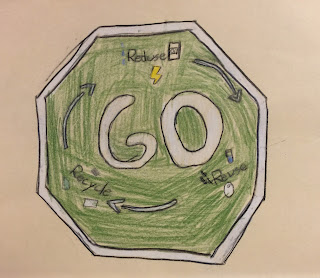Monday, September 28, 2015
Arrays
After this discussion, the kids spend some time finding different arrays around our room. We talk about the dimensions of the arrays found, as well as how many items are in the arrays. This is added to our journal.
Posted by Rebecca May at 6:36 AM 0 comments
Labels: 4th grade, Arrays, Factors, multiplication
Friday, September 25, 2015
Matter Rotations
 This week we reviewed mass, volume, and density, and also began discussing the idea of conductors of heat. (We'll talk more about conductors when we get to circuits.) The students went through rotations covering each topic.
This week we reviewed mass, volume, and density, and also began discussing the idea of conductors of heat. (We'll talk more about conductors when we get to circuits.) The students went through rotations covering each topic.Rotation #1 was a can of Coke and a can of Diet Coke, and the students placed them in a tub of water to measure distance each sank. The regular coke sank to the bottom, while the Diet Coke did not. This lead to a discussion about the mass of sugar versus the mass of artificial sweetener, and their relative densities. I brought in a sample of each so that the students could feel the difference in mass. It a BIG difference!
Rotation #2 included a wooden spoon, a plastic spoon, a rubber spoon, and a metal spoon. The students predicted which spoon(s) would be good conductors of heat, then we put the spoons in hot water for 1 minute. We took the spoons out and timed how long it took for a small piece of butter to begin melting when placed on the spoon. We quickly noticed the metal was by far the best conductor.
Rotation #3 was about predicting and measuring the volumes of different liquids.
Rotation #4 included measuring the mass of many different objects using a triple beam balance.

Thursday, September 24, 2015
Density Tubes
 |
| Beginning the density tube |
We're discussing density in science, so to explore it a bit, we used three different solutions and determined their relative density. Before class I prepared three solutions. Solution #1 was 400mL of water and 10 drops of blue food coloring. Solution #2 was 400 mL of water, 10 drops of red food coloring, and 3 tablespoons of salt. Solution #3 was 400 mL of water, 10 drops of green food coloring, and 6 tablespoons of salt. The kids did not know the properties of the liquids. Their only instructions were to build the density tube, and add the liquids in a way that the layers stayed separate. All the kids began in different orders, and they all had a mix of liquids! After lots of trial-and-error, all the groups were able to get their liquids into the correct order. I discussed with each group individually why the liquids had to be ordered in this way. We discussed density, which liquid must be our most dense, and which liquid must be our least dense. We also related the density of the red liquid to the other liquids.
 |
| A completed density tube |
Multiplying by Multiples of 10
Posted by Rebecca May at 7:01 AM 0 comments
Labels: 4th grade, multiplication
Thursday, September 17, 2015
Measuring, Comparing, and Contrasting Matter
When practicing our ability to measure, compare, and contrast objects, we began by observing a group of objects and listing out their physical properties. Physical properties are simply the observable characteristics of an object. Then the students tested to see if each object was magnetic or not. After we recorded our results, we thought about characteristics that might make an object magnetic, and if those characteristics ALWAYS make an object magnetic. For example, is an object magnetic simply because it feels like it is made of metal?
Our final discussion was led by these two questions: Does the state of matter affect whether an object sinks or floats? No, because we had solids that both sink and float and liquids that both sink and float. Does the mass affect whether an object sinks or floats? Yes, the higher masses sink, while the lower masses float.
 |
| Measuring Water Displacement |
 |
| Density Test |
Posted by Rebecca May at 8:05 AM 0 comments
Labels: 4th grade, Comparing and Contrasting Matter, Density, Mass, Science, Volume
Tuesday, September 15, 2015
Addition Strategies
It's important the kids know different ways to solve problems. First, it helps them move to the most efficient way possible. Second, it assists in their checking of the problems. Super important!!
Posted by Rebecca May at 9:13 AM 0 comments
Labels: 4th grade, addition, math, Place Value
Friday, September 11, 2015
Conserving our Resources
Posted by Rebecca May at 2:19 PM 0 comments
Friday, September 4, 2015
Tools Rotation
Posted by Rebecca May at 1:40 PM 0 comments
Wednesday, September 2, 2015
Lab Safety
Today we discussed lab safety. After our class discussion of rules for the science lab, I gave the children the task of drawing a lab scene which included both correct behavior, and incorrect behavior. They then had to label these behaviors.
Posted by Rebecca May at 12:40 PM 0 comments
Labels: 4th grade, Lab Safety, Science

































